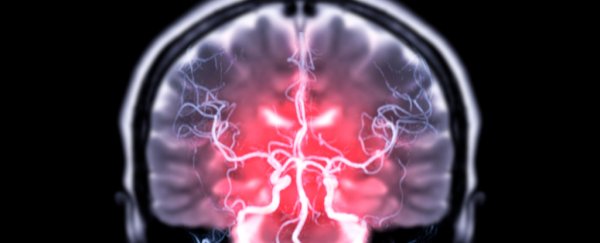The human brain gobbles up to 10 times more energy than the rest of the body, eating through 20 percent of our fuel intake on average when we're resting.
Even in comatose patients who are said to be 'brain dead', only two to three times less energy is consumed by the brain.
It's one of the great mysteries of human neuroscience: why does a largely inactive organ continue to require so much power?
A new study pins the answer to a tiny and secret fuel-guzzler, hiding within our neurons.
When a brain cell passes a signal to another neuron, it does so via a synapse, or a small gap between them.
First, the pre-synaptic neuron sends a bunch of vesicles to the end of its tail, closest to the synapse. These vesicles then suck in neurotransmitters from within the neuron, acting sort of like 'envelopes' that hold messages in need of being mailed.
These filled 'envelopes' are then transported to the very edge of the neuron, where they 'dock' and fuse to the membrane, releasing their neurotransmitters into the synaptic gap.
Once here, these transmitters connect to receptors on the 'post-synaptic' cell, thereby continuing the message.
We already know that the steps in this fundamental process require a substantial amount of the brain's energy, especially when it comes to vesicle fusing. Nerve ends (terminals) closest to the synapse cannot store sufficient energy molecules, which means they have to synthesize them on their own to conduct electrical messages in the brain.
So it makes sense that an active brain consumes a lot of energy. But what happens to this system when neural firing goes silent and the vesicle never docks to the membrane? Why does the organ continue to guzzle up power?
To figure this out, researchers designed several experiments on nerve terminals, which compared the metabolic state of the synapse when active and when inactive.
Even when nerve terminals were not firing, the authors found synaptic vesicles had high metabolic energy demands.
The pump that is responsible for pushing protons out of the vesicle and thereby sucking neurotransmitters in never seems to rest. And it requires a steady stream of energy to work.
In fact, this 'hidden' pump was responsible for half of the resting synapse's metabolic consumption in experiments.
That's because this pump tends to be leaky, researchers say. As such, synaptic vesicles are constantly spilling out protons via their pumps, even if they are already full of neurotransmitters and if the neuron is inactive.
"Given the vast number of synapses in the human brain and the presence of hundreds of SVs at each [of] these nerve terminals, this hidden metabolic cost of quickly returning synapses in a 'ready' state comes at the cost of major [presynaptic energy] and fuel expenditure, likely contributing significantly to the brain's metabolic demands and metabolic vulnerability," the authors conclude.
Further research is needed to glean how different types of neurons may be affected by such high metabolic burdens because they might not all respond in the same way.
Some neurons in the brain, for instance, may be more vulnerable to energy loss, and figuring out why could allow us to preserve these messengers, even when deprived of oxygen or sugar.
"These findings help us understand better why the human brain is so vulnerable to the interruption or weakening of its fuel supply," says biochemist Timothy Ryan from Weill Cornell Medicine in New York City.
"If we had a way to safely lower this energy drain and thus slow brain metabolism, it could be very impactful clinically."
The study was published in Science Advances.
